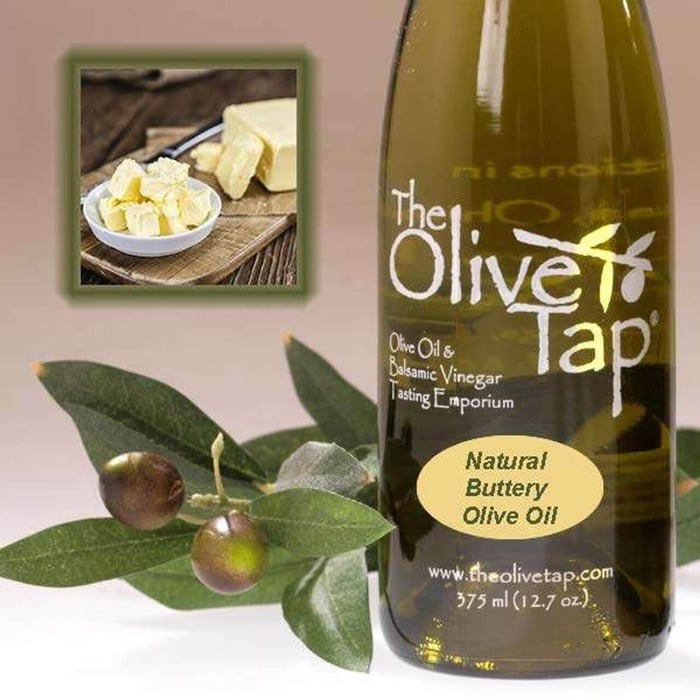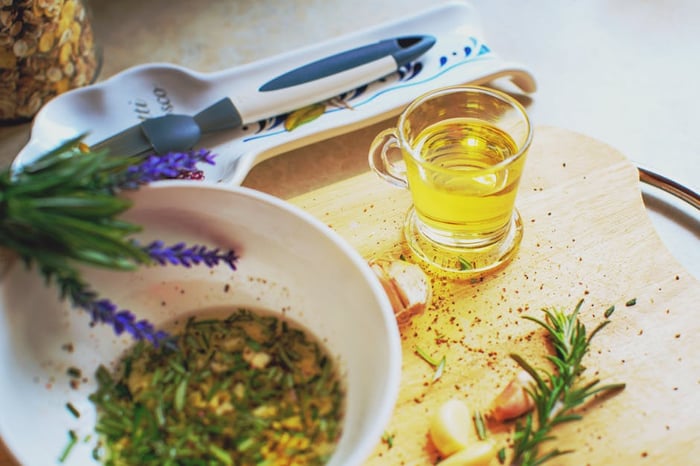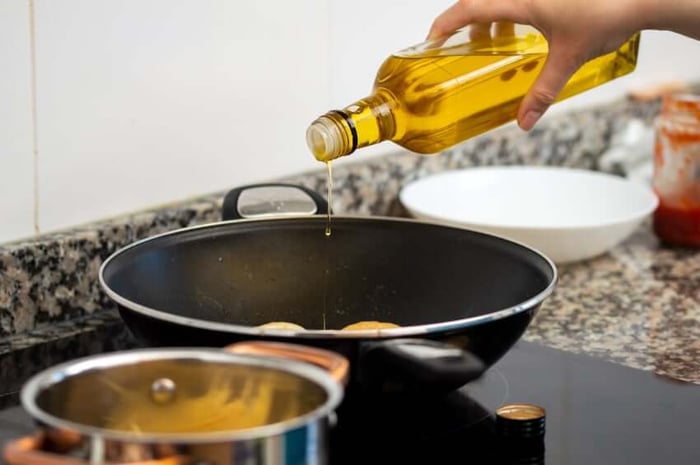Our Blog
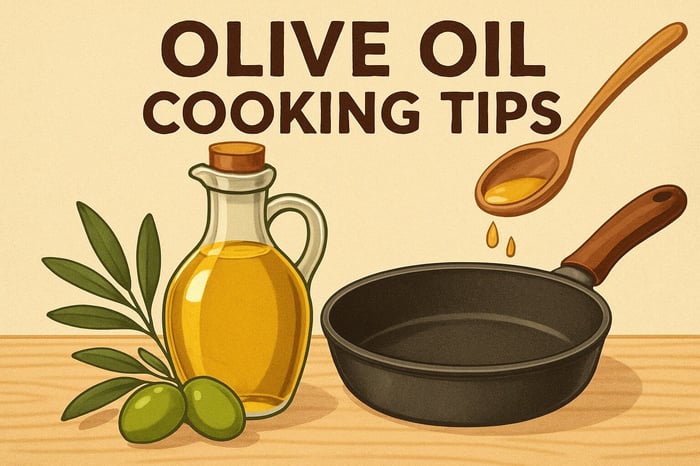
Don't Slip Up! Expert Olive Oil Cooking Tips You Need to Know
Why Olive Oil Cooking Tips Matter More Than You Think
Olive oil cooking tips can transform your kitchen game, but myths about heating olive oil have kept many home cooks from using this healthy fat to its full potential. The truth? High-quality extra virgin olive oil is not only safe for cooking—it's often superior to other oils.
Essential Olive Oil Cooking Tips:
- Use extra virgin olive oil for cooking up to 375°F (190°C). Note, EVOO has a smoke point between 375°F - 400°F (204°C).
- Use high polyphenol EVOOs for drizzling and finishing dishes for the ultimate flavor impacts.
- Store properly in dark, cool places away from heat sources.
- Replace butter using a 3:4 ratio (3/4 cup olive oil for 1 cup butter). Note: See Conversion Guidelines for detailed conversion by teaspoons and up.
- Monitor temperature with a thermometer to avoid exceeding smoke point.
- Reuse frying oil up to 4-5 times if not overheated and based on the foods cooked.
The biggest misconception? That olive oil's smoke point makes it unsuitable for cooking. Research shows that oxidative stability matters more than smoke point—and olive oil's natural antioxidants and high oleic acid content make it remarkably stable under heat.
A study by Acta Scientific Nutritional Health found that extra virgin olive oil produced fewer harmful compounds than canola and sunflower oils when heated to 240°C and held at 180°C for 6 hours. Meanwhile, cooking vegetables in olive oil actually increases absorption of their beneficial compounds.
Whether you're sautéing vegetables, searing proteins, or even deep frying, the right olive oil techniques will boost both flavor and nutrition in your cooking.
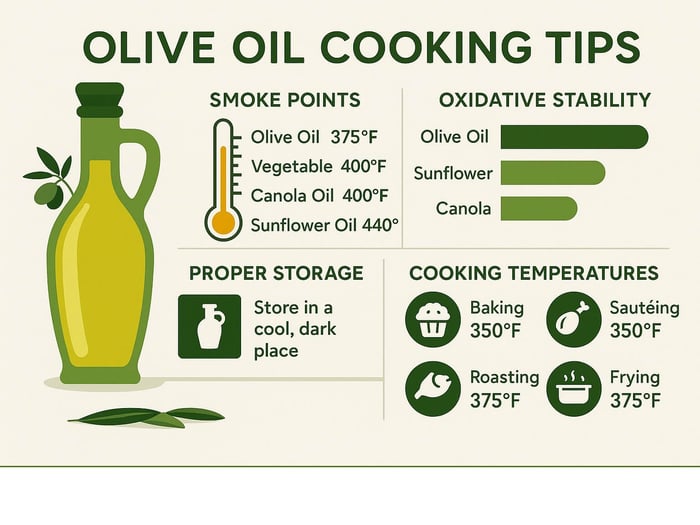
Understanding Olive Oil Grades, Smoke Point & Stability
Walking down the cooking oil aisle can feel overwhelming, but here's the truth: not all olive oils are created equal. Understanding the differences between grades is one of the most important olive oil cooking tips for home cooks who want to maximize both flavor and health benefits.
Extra Virgin Olive Oil (EVOO) sits at the top of the quality pyramid. Made by crushing fresh olives and pressing the oil without any chemical processing, it must contain less than 0.8% free fatty acids to earn this designation. This mechanical extraction preserves the most flavor, vibrant color, and beneficial compounds. High-quality EVOO typically has a smoke point ranging from 374°F to 410°F (190°C to 210°C), making it perfectly suitable for most home cooking methods.
Virgin Olive Oil follows the same natural extraction process but allows up to 4% free fatty acids. While it offers slightly less intense flavor and marginally higher smoke point, it's still a solid choice for cooking.
Light or Refined Olive Oil undergoes chemical processing to remove impurities and flavor compounds. Though it boasts a higher smoke point around 464°F (240°C), this processing strips away the antioxidants and health benefits that make olive oil special in the first place.
Here's where it gets interesting: oxidative stability matters far more than smoke point alone. The high concentration of monounsaturated fats (MUFAs) in olive oil, particularly oleic acid, combined with natural antioxidants like polyphenols and vitamin E, creates remarkable stability under heat. Research shows olive oil can withstand frying for 24-27 hours compared to just 15 hours for many vegetable oils.
Tap's Tip: As you will see across many articles and internet research, smoke point ranges often varies for many oils, it is important to have a careful eye when cooking with just about any oil. Watch for signs of glistening before it starts to smoke.
| Oil Type | Smoke Point | Oxidative Stability | Best Uses |
|---|---|---|---|
| Extra Virgin Olive Oil | 374-410°F | High (due to antioxidants) | All cooking methods, finishing |
| Refined Olive Oil | 464°F | Moderate | High-heat cooking |
| Canola Oil | 400°F | Low | General cooking |
| Sunflower Oil | 450°F | Very Low | Limited high-heat use |
The Science Behind Heat & Health
When oils heat up, they can form polar compounds and other potentially harmful substances. But here's what makes olive oil different: its unique fatty acid profile acts like built-in armor against heat damage.
Oleic acid, which makes up about 70-80% of olive oil's fatty acid composition, resists oxidation remarkably well. This means fewer harmful compounds form during cooking compared to oils high in polyunsaturated fats.
A comprehensive study heated various oils to 240°C and found that extra virgin olive oil produced remarkably low levels of unhealthy polar compounds compared to seed oils. Even after prolonged heating to 356°F (180°C) for 36 hours, olive oil retained most of its beneficial compounds including oleic acid, sterols, and squalene.
Myth-Busting the Smoke Point Obsession
Let's tackle the biggest myth head-on: the smoke point obsession. Yes, smoke point—the temperature where oil breaks down and produces visible smoke—matters. But it's been wildly overemphasized in cooking advice.
Think about your actual cooking temperatures. Sautéing typically happens at 250-300°F, while even aggressive searing rarely exceeds 400°F. Most home cooking never approaches the smoke points that cause concern.
Professional chefs have known this secret for years: focus on oil quality and stability rather than obsessing over smoke point numbers. The natural antioxidants in olive oils act as built-in protection against heat damage, making them safer and more stable than many refined oils with technically higher smoke points.
Scientific research on oil emissions confirms that olive oil produces fewer volatile aldehydes and toxic compounds than many seed oils when heated. This makes it not just a flavorful choice, but a healthier one for your cooking trips.
The bottom line? High-quality olive oil isn't just safe for cooking—it's often your best choice for both flavor and health.
Olive Oil Cooking Tips for Every Technique
Ready to open up the full potential of your kitchen? Mastering different cooking techniques with olive oil is easier than you might think—and the results are absolutely worth it.
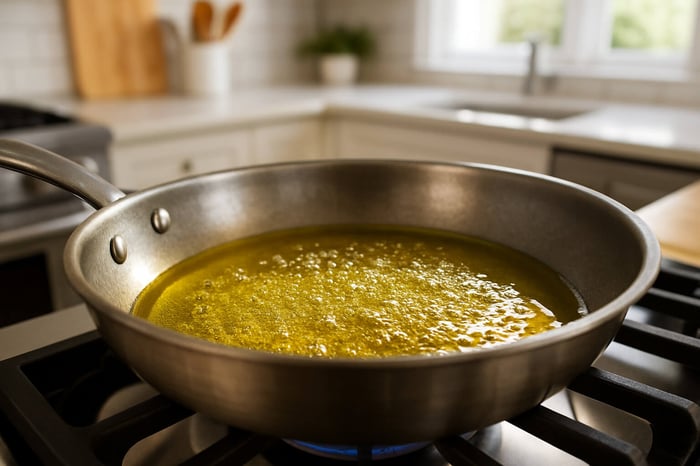
Here's a game-changing tip that professional chefs swear by: always heat your olive oil until it shimmers—about 40 seconds on medium heat—before adding any food. This simple step ensures even cooking and transforms the oil into a flavor vehicle that distributes seasonings and aromatics beautifully throughout your dish.
A splatter guard becomes your best friend when cooking with ingredients that have higher moisture content. Trust me on this one—it prevents burns and keeps your stovetop from looking like a crime scene. And if you're serious about getting consistent results, invest in a cooking thermometer. It takes the guesswork out of maintaining proper temperatures, especially when you're venturing into frying territory.
The science backs up what many home cooks are finding: scientific research on frying stability shows that olive oil remains remarkably stable and produces fewer harmful compounds than seed oils during frying at temperatures between 320°F and 374°F (160°C to 190°C).
Low-to-Medium Heat Mastery
Low-to-medium heat cooking (250-325°F) is where olive oil absolutely shines, and once you experience the difference, you'll never go back. When you're sweating vegetables for a sofrito base or building complex sauce flavors, olive oil works magic at the molecular level.
Here's what's happening behind the scenes: olive oil's natural compounds actually improve how your body absorbs fat-soluble vitamins and bioactive compounds from ingredients like garlic, onions, and tomatoes. It's not just cooking—it's creating a nutrient boost that studies confirm increases the absorption of antioxidants and beneficial compounds compared to other cooking methods.
Think of olive oil as both your cooking medium and your personal nutrition delivery system. Pretty amazing for something so simple, right?
High-Heat Heroes: Searing & Shallow Fry
Here's where we bust another cooking myth wide open: high-quality extra virgin olive oil doesn't just survive high-heat applications like searing steaks or shallow-frying—it excels at them. The key is smart temperature control, keeping your heat between 350-375°F for optimal results without pushing the oil beyond its comfort zone.
When you're searing proteins, olive oil's natural stability means you can achieve that perfect golden caramelization without any off-flavors or the formation of harmful compounds. For more delicate dishes where you want the food's natural flavors to take center stage, choose a neutral-flavored variety that won't compete for attention.
Can You Deep Fry with EVOO? Olive Oil Cooking Tips Answered
The short answer? Absolutely! You can deep fry with extra virgin olive oil, and the results might surprise you. The ideal temperature for deep frying sits around 356°F (180°C)—comfortably within the range of quality EVOO.
Now, let's talk practicality. While cost considerations might make this more of a special occasion choice rather than your everyday frying method, olive oil brings some serious advantages to the deep-frying game. It can be reused 4-5 times if you treat it right—filter after each use and store it properly between cooking sessions.
The oil's natural stability means it degrades more slowly than many alternatives, making it surprisingly economical for repeated use. Who knew being health-conscious could also be budget-smart?
For professional techniques and detailed guidance that'll take your cooking to the next level, explore cooking with olive oil.
Flavor Boosters: Pairing, Infusions & Baking Swaps
Think of olive oil as the supporting actor that can steal the show. Understanding olive oil cooking tips for flavor pairing transforms ordinary meals into memorable experiences. Different varieties offer distinct personalities that can either whisper subtly in the background or boldly announce themselves.
Mild oils like Arbequina are the diplomatic choice—they bring richness without picking fights with delicate flavors. These gentle varieties work beautifully in light vinaigrettes, tender sautés, or baking applications where you want luxurious texture without overwhelming other ingredients.
Robust oils like Koroneiki or Picual varieties are the bold personalities of the olive oil world. They bring peppery, intense notes that can stand up to hearty soups, grilled vegetables, or finish a perfectly seared steak. These oils don't just add fat—they add character.
Infused olive oils take flavor improvement to the next level. These flavor-improved oils can transform simple dishes into gourmet experiences with just a drizzle.
Lemon Ricotta Cheesecake with Sorrento Lemon Crust and Raspberry Agretti Compote
Matching Oil Intensity to Dishes
The secret to successful pairing lies in finding balance, not competition. Light, citrusy oils complement seafood and delicate salads without masking their natural flavors. Think of them as the perfect dance partner—supportive but never overpowering.
Full-bodied, peppery oils thrive alongside red meat and robust vegetables. They can handle the intensity of grilled portobello mushrooms or the richness of braised short ribs. Medium-intensity oils serve as excellent all-purpose cooking companions, providing flavor depth while respecting delicate ingredients.
DIY & Store-Bought Infusions
Creating infused oils at home is like conducting a flavor orchestra, but safety must be your first violin. Heat-infusion methods create immediate gratification but should be used the same day. Cold-infusion techniques require proper storage to prevent unwanted bacterial guests from joining the party.
Store-bought infused oils offer convenience and professional safety standards. Artisan producers understand the delicate balance between flavor extraction and food safety, ensuring you get maximum taste without any risks.
Popular infusion combinations that consistently deliver include Rosemary and Garlic for roasted potatoes and grilled meats, Lemon and Herbs for seafood, vegetables or Mediterranean-inspired dishes, Basil and Garlic for pasta and pizza finishing. The flavor combinations are endless so check out our Perfect Pairings.
Baking with Olive Oil for Healthier Treats
Substituting olive oil for butter in baking isn't just about health—it's about creating incredibly moist textures and adding subtle fruity notes that make people wonder about your secret ingredient. The conversion is refreshingly straightforward: use 3/4 cup olive oil for every 1 cup of butter, 1/3 cup oil for 1/2 cup butter, 3 tablespoons oil for 1/4 cup butter, and 2 1/4 teaspoons oil for 1 tablespoon butter. See our Butter to Olive Oil Conversion Guide.
Choose mild, fruity olive oils for sweet applications to avoid overwhelming delicate cake and cookie flavors. The oil's natural antioxidants also help extend the shelf life of your baked goods—a practical bonus that your future self will appreciate.
The result? Cakes stay moist longer, muffins have tender crumbs, and you've sneaked heart-healthy fats into dessert without anyone being the wiser. Explore creative applications in our Recipes section for inspiration on incorporating olive oil into both sweet and savory baking trips.
Storage, Reuse & Sustainability
Proper storage maximizes olive oil's lifespan and maintains its beneficial properties. The enemies of olive oil are light, heat, and air—all of which accelerate oxidation and rancidity.
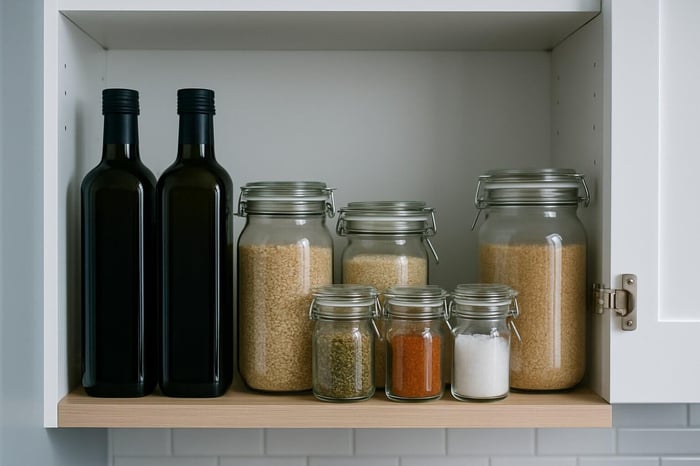
Store olive oil in darker glass bottles or containers, away from heat sources like stoves and ovens. A cool cupboard maintains optimal conditions, and there's no need to refrigerate unless you live in extremely hot climates.
High-quality olive oil maintains its integrity for at least 12 months when stored properly. For best flavor and nutritional value, try to use within 6-12 months of purchase.
How to Tell When Used Oil Has Had Enough
Cooking oil—whether olive or otherwise—has clear signs when it's time for disposal:
- Excessive smoking at normal cooking temperatures
- Persistent foaming when heated
- Off-odors resembling paint or rancid nuts
- Dark, thick consistency that doesn't flow normally
- Bitter or unpleasant taste when cooled
Trust your senses—if something seems off, it probably is.
Smart Ways to Recycle or Dispose
Never pour used cooking oil down drains or toilets, as it can cause serious plumbing and environmental problems. Instead:
- Small amounts can be absorbed into paper towels and composted
- Larger quantities should be taken to local recycling centers that accept cooking oil
- Some municipalities offer special collection programs for used cooking oil
- Auto shops sometimes accept cooking oil for biodiesel programs
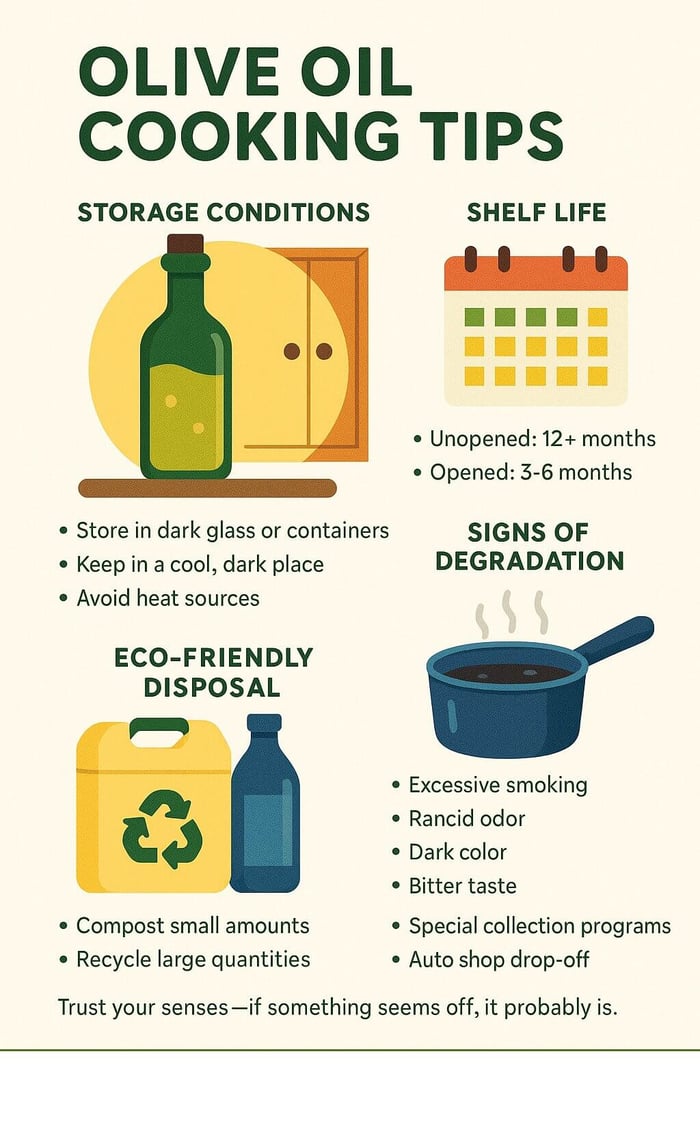
FAQs
Is heating olive oil bad for its antioxidants?
This question comes up constantly, and it's understandable why people worry about it. The truth is more nuanced than a simple yes or no.
Some delicate compounds do break down when you heat olive oil—particularly some of the flavor compounds and certain polyphenols that give extra virgin olive oil its distinctive taste and aroma. But here's the important part: the majority of olive oil's beneficial compounds remain remarkably stable even after prolonged heating.
The heavy hitters like oleic acid, sterols, and squalene stick around even when you're cooking at higher temperatures. Research shows that these compounds—which provide most of olive oil's health benefits—remain intact even after heating to 356°F (180°C) for extended periods.
Think of it this way: you're still getting significantly more health benefits from cooking with olive oil than you would from using highly processed seed oils or vegetable oils, even if you lose a small percentage of the most delicate antioxidants. It's like choosing between a slightly bruised apple and a candy bar—the apple is still the better choice.
Can I reuse olive oil for frying?
Absolutely, and it's one of the best oils for reusing! This might surprise you if you've been told otherwise, but olive oil's natural stability makes it superior to many other oils when it comes to multiple uses.
You can safely reuse olive oil 4-5 times for frying, provided you follow a few simple guidelines. Don't let it overheat beyond its comfort zone, and always filter out food particles after each use. Store the cooled oil in a clean container away from light and heat.
The key is monitoring the oil's condition. As long as it doesn't smoke excessively, foam persistently, or develop off-odors, you're good to go. Olive oil's natural antioxidants actually help protect it from breaking down as quickly as other oils.
Pro tip: Label your container with the date and keep track of how many times you've used it. Your nose and eyes are your best guides—if something seems off, trust your instincts and start fresh.
Are there dishes where olive oil is not ideal?
The main limitations are practical rather than culinary. Deep frying large quantities can get expensive when you're using premium extra virgin olive oil, though it's perfectly safe and delicious if budget isn't a concern. For everyday deep frying, you might choose a more economical option.
Flavor preferences account for most other situations. If you're making a delicate vanilla cake and want absolutely zero competing flavors, you might opt for a truly neutral oil. But even then, choosing a mild olive oil variety often works beautifully and adds subtle richness.
Some people avoid olive oil in Asian stir-fries, preferring traditional flavors, but that's purely a matter of taste and authenticity rather than cooking performance. Olive oil actually performs excellently in high-heat stir-frying.
The bottom line: unless you have a specific flavor profile in mind or budget constraints for large-quantity frying, olive oil works wonderfully in virtually every cooking application. Don't let myths hold you back from enjoying its benefits and flavor in your everyday cooking.
Conclusion
These olive oil cooking tips have hopefully changed how you think about this incredible ingredient. For too long, myths about smoke points and heat damage have kept home cooks from experiencing olive oil's full potential in the kitchen.
The truth is refreshingly simple: olive oil isn't just safe for cooking—it's often your best choice. Its natural antioxidants and high oleic acid content make it more stable under heat than many oils with higher smoke points. Whether you're gently sweating onions for a sauce
base or getting a perfect sear on tonight's dinner, olive oil delivers both exceptional performance and genuine health benefits.
The science backs this up completely. Studies consistently show that olive oil produces fewer harmful compounds when heated compared to many seed oils, while actually helping your body absorb more nutrients from the foods you're cooking.
Start putting these techniques into practice today—you'll be amazed at the difference. Remember the key principles: select the right olive oil (mild or robust, flavored or unflavored) keep an eye on temperatures, and store your oils properly to maintain their quality.
The journey from good cooking to great cooking often comes down to using quality ingredients. Our carefully selected Olive Oils come from award-winning artisan producers who understand that the best cooking oils start with the finest olives and traditional pressing methods.
Every bottle represents the perfect marriage of culinary excellence and nutritional benefits. When you're ready to experience what real olive oil can do for your cooking, you'll find options that work beautifully for everything from everyday sautéing to special occasion deep frying.
Your kitchen trips are about to get a whole lot more delicious—and healthier too.


